管理学原理--第三讲:组织变革
组织变革管理课件
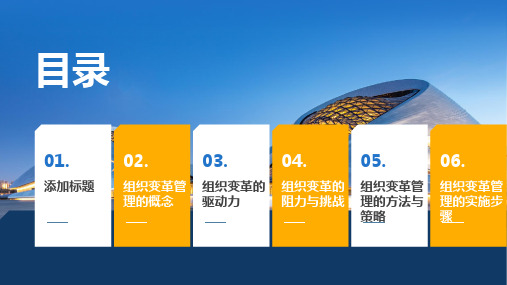
持续改进与反馈机制的关 系:两者相辅相成,共同 促进组织变革管理的成功
反馈机制:建立有效的反 馈机制,及时收集和反馈 信息,以便及时调整和改
进
持续改进与反馈机制的实 施:制定明确的目标和计 划,定期评估和调整,确 保持续改进与反馈机制的
有效实施
04
组织变革管理的成功要素
07
高层领导的支持
高层领导对变革的认同和支 持
高层领导的积极参与和决策
高层领导对变革的推动和监 督
高层领导对变革的激励和奖 励
跨部门协作与沟通
建立跨部门协作机制,确保信息共享和资源整合 加强跨部门沟通,提高工作效率和协同能力 培养跨部门协作文化,增强团队凝聚力和归属感 建立跨部门沟通平台,及时解决跨部门协作中的问题
添加 标题
政策法规:政府政策法规的调整, 如税收政策、环保政策等
添加 标题
经济环境:经济环境的变化,如经 济增长、通货膨胀等
添加 标题
市场竞争:行业竞争加剧,企业需 要不断调整战略以适应市场变化
添加 标题
社会文化:社会文化变迁,如消费 观念、价值观等变化
内部发展需求
提高组织效率:通过变革 提高组织运行效率,降低
适应环境变化:组织变革管理可以帮助组织适应外部环境的变化,保持竞争 力。 提升组织竞争力:通过变革管理,可以提升组织的核心竞争力,提高市场份 额。
促进组织创新:组织变革管理可以激发组织的创新活力,推动组织持续发展。
组织变革的驱动力
03
外部环境变化
添加 标题
技术进步:新技术的出现和普及, 如人工智能、大数据等
组织变革管理的目的是提高组织的竞争力和适应能力,实现组织的可持续发展。
组织变革管理的内容包括:组织结构调整、流程优化、文化变革、人力资源管理等。
管理学之——组织变革和组织文化
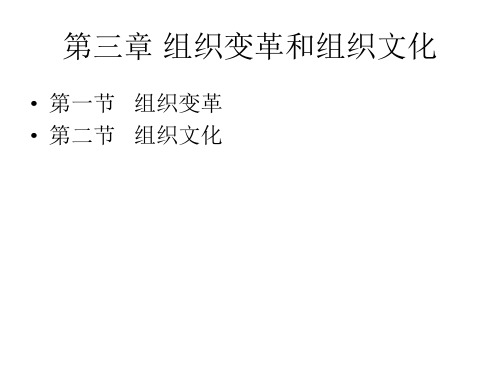
组织变革的阻力及其管理
1、 组织变革的阻力
(1)个人阻力:利益上的影响;心理上的影 (2)团体阻力:组织结构变动的影响;人际关系调整
的影响 2、消除组织变革阻力的对策
(1)分析变革的阻力和推力的强弱 (2)创新组织文化 (3)创新策略方法和手段
组织变革失败的原因
• 在公司各层管理人员还没有形成危机感、紧 迫感的时候,就开始实施变革; • 未能建立起强有力的联合指导委员会; • 低估了设想、目标的作用; • 设想、目标的宣传效果不佳; • 对阻挠新设想付诸实施的之中障碍听之任之; • 未能创造短期效益; • 过早宣布获得成功; • 不重视使改革意识扎根于企业文化之中.
第三章 组织变革和组织文化
• 第一节 组织变革 • 第二节 组织文化
第一节 组织变革
• 哈默和钱皮在《公司再造》一书中指出: 三“C”力量,即:顾客(Customers),竞 争(Competition),变革(Change),并 认为变革最重要。
• 所谓组织变革:内外环境的变化,对要素 和关系调整,适应要求。
以产权清晰、权责明确、政企分开、管理科学为 基本特征的一种新型的企业制度。
现代企业制度
• 三、特征: • 1.产权清晰
• 2.权责明确 • 3.政企分开 • 4.管理科学
组织变革的动因与目标
– 组织变革的目标
• (1)使组织更适应环境 • (2)使管理者更适应环境 • (3)使员工更适应环境
组织变革的内容与程序
1、组织变革的内容:
(1)人员变革 (2)结构变革 (3)技术与任务的变革
2、组织变革的程序:
(1)通过组织诊断,发现变革征兆 (2)分析变革因素,制定改革方案 (3)选择正确方案,实施变革计划 (4)评价变革结果,及时进行反馈
(自考)管理学原理(重点规划)第三篇-组织工作

第三篇组织工作(七)组织工作的含义1、组织工作:就是设计和维持一种有助于有效的集体活动的组织结构的活动工程。
2、组织结构:是组织中划分、组合和协调人们的活动和任务的一种正式框架,表现为组织各部门的排列顺序、空间位置、聚集状态、联系方式和相互关系。
3、组织工作的内容:1.组织职位设计2.组织结构纵向划分3。
组织结构横行划分4.职权配制5.组织结构的协调6。
组织结构的调整4、组织工作的特点:1.组织工作是一个过程2.组织工作是动态的3.组织工作要充分考虑非正式组织的影响5、影响组织结构选择的因素:1.技术2。
外界环境3。
组织的规模4。
组织的生命周期5.组织的战略6、组织工作的原理:1.目标统一原理2。
分工协作原理3.管理宽度原理4。
责权一致原理5.集权与分权相结合的原则6.稳定性与适应性相结合的原理7、目标统一原理:是指组织中每个部门或个人的贡献越有利于实现组织目标,组织结构就越合理有效。
8、分工协作原理:是指组织结构越能反映出为实现组织目标所必要的各项任务和工作分工,以及相互间的协调,组织结构就越精干高效.9、管理宽度原理:是指组织中管理者监督管辖其直接下属的人数越适当,就越能够保证组织的有效运行。
10、责权一致原理:是指在组织结构设计中,职位的职权和职责越相对一致,组织结构就越有效。
11、集权与分权相结合的原则:是指对组织中职权的集权与分权的关系,处理的越适中,就越有利于组织的有效运行。
12、稳定性与适应性相结合的原理:是指越能在组织结构的稳定性与适应性之间取得平衡,就越能保证组织的正常运行。
(八)组织结构设计与类型1、职位设计:就是将若干任务组合起来构成一项完整的职位。
2、专业化分工的优缺点:优点:1.有利于提高人员的工作熟练程度2.有利于减少因工作变换而损失的时间3。
有利于使用专用设备和减少人员培训的要求缺点:员工因工作单调乏味,产生厌烦和不满情绪,影响了总体的工作效率和质量.3、为避免过度专业化分工,职位设计的做法:1.职位扩大化2.职位轮换3。
管理学原理与实践(第七版_罗宾斯博士管理学最新力作)知识要点归纳
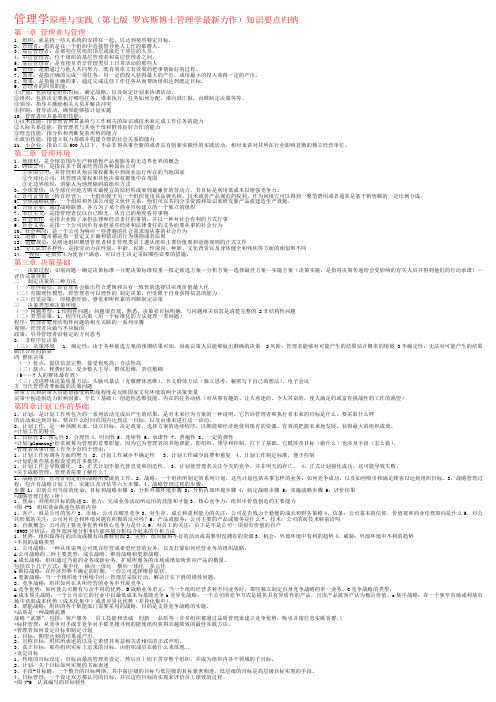
管理学原理与实践(第七版罗宾斯博士管理学最新力作)知识要点归纳第一章管理者与管理1、组织:就是将一些人系统的安排在一起,以达到某些特定目标。
2、管理者:指的是在一个组织中直接督导他人工作的那群人。
3、高层管理者:是那些位居组织顶层或接近于顶层的人员。
4、中层管理者:位于组织的基层管理者和高层管理者之间。
5、基层管理者:是直接负责非管理类员工日常活动的那些人6、管理:是指通过与他人共同努力,既有效率又有效果的把事情做好的过程。
7、效率:是指正确的完成一项任务,用一定的投入获得最大的产出,或用最小的投入获得一定的产出。
8、效果:是指做正确的事,通过完成这些工作任务从而帮助组织达到既定目标。
9、管理者的四项职能:②组织:包括决定要执行哪些任务,谁来执行,任务如何分配,谁向谁汇报,由谁制定决策等等。
③领导:指导并激励相关人员并解决冲突④控制:督导活动。
确保能够按计划实施10、管理者应具备的职技能:①技术技能:指管理者所具备的与工作相关的知识或技术来完成工作任务的能力②人际关系技能:指管理者与其他个体和群体良好合作的能力③理念技能:指分析和判断复杂形势的能力④政治技能:指建立权力基础并构建合理的社会关系的能力11、小企业:指员工在500人以下,不必非得从事全新的或者具有创新实践性的实践活动,相对来讲对其所在行业影响甚微的独立经营单位。
第二章管理环境1、地球村:是全球范围内生产和销售产品和服务的无边界世界的概念2、跨国公司:是指在多个国家经营的各种国际公司②全球化公司:其管理决策权和其他决策权都集中在母国③无边界组织:消除人为地理障碍的组织方式3、全球筹供:从全球任何地方购买最便宜的原材料或雇佣最廉价的劳动力,其目标是利用低成本以增强竞争力。
4、许可证贸易(特许经营):一个组织授予另一个组织使用其品牌名称、技术或者产品规范的权利,作为回报它可以得到一整笔费用或者通常是基于销售额的一定比例分成。
5、全球战略联盟:一个组织和外国公司建立伙伴关系,他们可以共同分享资源和知识来研发新产品或建造生产设施。
组织变革讲义(ppt24页).pptx

组织变革方案
▪ 爆破式变革:采取变革性措施,打破旧的一套, 断然采取全新的方法。
▪ 改良式变革:逐步变革,在原有的框框内作一 些小的改革。
▪ 计划式变革:采取系统发展、统筹解决的办法。 先设想一个最佳的变革方案,建立变革系统模 型,确定解决问题的具体措施。一步一步地实 施,最终有效地完成组织的各种任务。
组织变革
朱宁
中国科技大学商学院
2020/10/2
1
©2002 by Shimai Researching
▪ 组织变革的概念
❖ 组织变革的基本概念 ❖ 组织变革的必要性 ❖ 组织变革信号
今天的话题
▪ 组织变革的内容
以组织结构为重点的变革 ❖ 以任务和技术为重点的变革 ❖ 以个人为重点的组织变革
▪ 组织变革实施
识
15 ©2002 by Shimai Researching
▪ 组织变革的概念
❖ 组织变革的基本概念 ❖ 组织变革的必要性 ❖ 组织变革信号
今天的话题
▪ 组织变革的内容
以组织结构为重点的变革 ❖ 以任务和技术为重点的变革 ❖ 以个人为重点的组织变革
▪组织变革实施(17—22)
❖组织变革方案 ❖组织变革程序 ❖组织变革模式
这些都说明组织的停滞。
6 ©2002 by Shimai Researching
组织变革公式
▪ 美国研究这格莱彻尔认为只看到了组织变革的 需要还不够,还需要辨别需要变革的程度,才 能下狠心是否真正变革。
C=(abd)>x
C指变革; a指对组织现状不满的程度; b指对组织变革后可能达到的情况的把握; d指组织变革实现的措施; x指变革需要花费的代价。
《管理学原理》组织变革
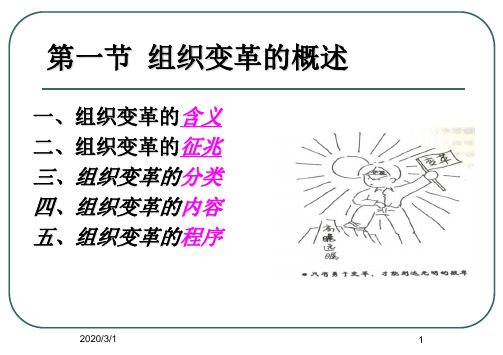
17
案例:李华刚的组织变革经历
李华刚的第一次失败变革
1990年被聘为湖北省襄樊市特种材料公司生产 副厂长,年仅26岁。
当时情况: 工厂生产系统混乱,技术落后,员工士气低落, 产品没有销路,几乎没有规则制度,连生产计 划、销售计划和采购计划都没有。
2020/3/1
18
李华刚上任后的改革:
2020/3/1
24
第二节 组织变革的模式
一、剧烈式变革与渐进式变革的比较 二、常见的几种变革模式
2020/3/1
25
一、剧烈式变革与渐进式变革的比较
渐进式变革 持续进步 维持平衡
剧烈式变革 突破框架
达到新平衡
影响组织局部
贯穿于正常的结 构与管理过程
转变整个组织
创立新的结构 与管理模式
创新性技术
显得无法接受和不可理解。
那些愚蠢的苍蝇则对事物的逻辑毫不留意,全然不顾亮光的吸引,四下乱飞,
结果误打误撞地碰上了好运气;这些头脑简单者总是在智者消亡的地方顺利得救。
因此,苍蝇得以最终发现那个正中下怀的出口,并因此获得自由和新生。
2020/3/1
2
上面所讲的故事并非寓言,而是美国密执安大学教授 卡尔·韦克转述的一个绝妙的实验。韦克是一个著名的 组织行为学者,著有《组织的社会心理学》等书。
的和必要性,配合不力,执行缓慢。
李华刚的结果: 怀着满腹抱怨离开公司
2020/3/1
20
李华刚的成功变革:
1998年,李华刚受聘于深圳合洪实业有限公司, 担任管理部经理,时年34岁。
公司当时的情况:
组织结构严重不合理,两个生产部门分别独立运 作,造成人员和物力资源的重叠和浪费;
管理学组织变革与创新ppt课件

解冻
变革
再冻结
11
7.2.2 组织变革的模式
(2)科特的领导变革八步骤 。约翰·科特提出了计划变革模型,它将 解冻、变革及重新冻结三阶段扩展为八个有明确定义的步骤,如图所 示:
第8步:使新工作办法制度化 第7步:巩固已有成果 第6步:计划并夺取短期胜利 第5步:授权他人实施愿景规划 第4步:沟通愿景规划 第3步:构建愿景规划 第2步:建立强有力的领导联盟 第1步:形成紧迫感
外部动力
• 经济的力量 • 技术的进步 • 社会和政治变革 • 就业人口的改变
内部动力
• 组织目标的改变 • 管理条件的变化 • 组织发展阶段的变化 • 组织成员社会心理及价值观的改变 • 组织内部的矛盾与冲突
3
管理学基础 (第二版)
公共管理核心课程系列教材
7.1.2 组织变革的类型
管理人员可以致力于组织内的四种变革类型,以获 取战略优势。这四种变革的战略类型是:技术变革、 产品与服务变革、战略与结构变革以及人员与文化变 革。
19
7.4.1 组织创新概述
2.创新的内涵
组织创新(organizational innovation)被认为是采纳一些对于组织所 在行业、市场或一般环境来讲是全新的构思或行为。关于创新和变革的区 别,被引用最多的应该是迈克尔·韦斯特(Michael West)及其同事的观 点,他们这样描述了组织创新的特征:
个人观
7
7.2.2 组织变革的方式
1 量变式和质变式 2 正式关系式、非正式关系 3 式 主和 动人 思员 变式 式和被动应变式 4 突变式和分段发展式 5 强制式、民主式和参与式 6 自上而下式、自下而上式和上下结合式
8
7.2.3 组织变革的模式
管理学组织变革与组织文化ppt课件
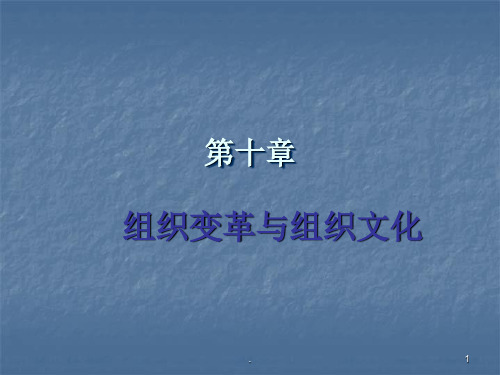
人才流动与组织的吐故纳新
.
5
3.组织变革的动因
组织必然要进行变革,因为组织是一个不断与 外界环境发生作用的开放系统。具体而言,推动 组织进行变革的因素可以分为外部环境因素和内 部环境因素。 a.外部环境因素:宏观社会经济环境的变化、科技进步、 资源变化、竞争观念的改变。 b.内部环境因素:企业自身成长的需要、保障信息 畅通的需要、克服组织低效率的需要、管理条件 的变化、人员条件的变化、技术条件的变化等。
.
13
10.2.2 组织变革的压力及其管理
压力是在动态的环境条件下,个人面对 种种机遇、规定以及追求的不确定性造 成的一种心理负担。(正面激励、负面激励)
压力的起因:组织因素、个人因素 压力的特征:生理、心理、行为
.
14
10.3 组织文化
10.3.1 组织文化的概念和特征
1.组织文化的基本概念
.
21
c. 伦理规范:社会公德。通过公众舆论规范
组织成员的行为
d. 组织素养:包括组织中各层级员工的基本思 想素养、科技和文化教育水平、工作技能、精 力以及身体状况等。素养越高,组织中的管理 哲学、敬业精神、人本主义的价值观念、道德 修养等就越深厚
e. 组织形象:社会公众和组织成员对组织、组 织行为和组织的各种活动成果的总体印象和
e. 选择性信息加工;
.
11
2.团体阻力
a. 对已有权力关系的威胁;
b. 对已有资源分配的威胁;组织结构变动
c. 对已有专业知识的威胁;
d. 结构惯性;
e. 群体惯性;
人际关系调整
f. 有限的变革点。
.
管理学原理:组织变革
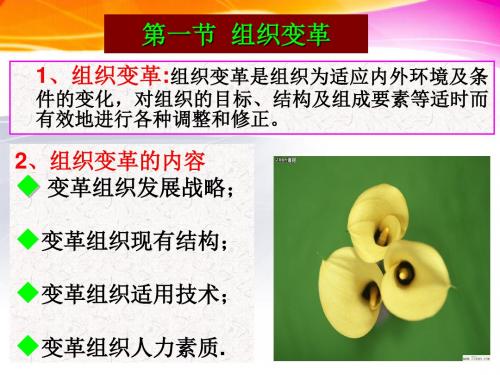
• 一、组织文化:企业在生产经营实践活动中 自觉形成的一种基本精神和凝聚力,是企业全 体职工认同信守的价观念、理想信仰、工作态 度、企业风尚和道德行为准则的总和。
二、组织文化的特征:
阶级性; 民族性 整体性; 历史性; 融和性; 创新性.
三、组织文化的内容:
策效率低或经常出现决策失误;
组织沟通渠道阻塞,信息不灵,人际关系
混乱,员工士气低落,不满情绪增加,部 门协调不力等;
组织缺乏创新;
组织职能难以正常发挥。
3、组织变革的程序
(1)发现并诊断发现的问题; (2)制定变革方针; (3)制定变革的具体计划、实 施步骤; (4)实施制定的变革; (5)评价计划实施效果。
4、组织变革失败的原因
在公司各层管理人员还没有形成危机感、紧 迫感的 时候,就开始实施变革; 未能建立起强有力的联合指导委员会; 低估了设想、目标的作用; 设想、目标的宣传效果不佳; 对阻挠新设想付诸实施的之中障碍听之任之; 未能创造短期效益; 过早宣布获得成功; 不重视使改革意识扎根于企业文化之中.
组织变革可预 主动性变革
见性
被动性变革
4、组织变革的目的
提高组织的适应能力; 增强组织的竞争实力; 改善组织的工作环境;
二、组织变革的影响因素
组织外部环境 组织内部条件
科技因素
组织战略
经济因素
ቤተ መጻሕፍቲ ባይዱ
组织成长
环境因素
组织文化
政治因素
人员素质
顾客因素
管理因素
组织 变革
2、组织需要变革的征兆
组织结构有缺陷,机构重复或不健全,决
5、如何实现有效的变革
组织变革-PPT课件

• 1、抵制变革的原因 • 1)、不确定感 • 2)、缺乏理解和信任 • 3)、害怕失去某些既得利益 • 4)、对变革的认识不同 • 2、消除抵制的方法 • 1)、宣传教育 • 2)、参与 • 3)、必要的妥协 • 4)、压制 • 5)、高层管理部门的支持
10
组织变革的必须性
1、设计再完美的组织,为更好适应组织内 外条件变化,在运行一段时间后,都必须 变革。
❖改革:按照所拟定的变革方案的要求开 展具体的组织变革运动或行动,以使组 织从现有结构模式向目标模式转变。
❖冻结:采取措施使新的行动方式和组织 形态能够不断的强化和巩固。
26
• 3、 组织变革的过程: – 成功而有效的组织变革,需要经历解冻、改革、冻结三个有机结合的过程。
– 1)解冻: – 是实施变革的前奏。
6
• 2)、变革阶段 • 即改革过程中行为转换阶段。在这一阶
段中,要把激发起来的改革动机转化为 改革的行为,关键措施是让员工参与变 革,使变革成为全体员工的共同事业。 组织领导者在变革阶段主要应遵循三个 原则: • (1)不动摇原则。 • (2)小步子原则。 • (3)应变原则。
7
• 3)、再冻结阶段 • 即改革后的行为强化阶段。由于人们的传统
➢ 对个人损失的担心
➢ 缺乏理解和信任
(二)组织方面的阻力来源
➢ 结构惯性
➢ 来自领导人的阻力
➢ 已有的权力关系
➢ 不同的评价和目标
➢ 改革焦点有限
➢ 即使环境变了,原有的组织模式并非立即失去作用
21
• 组织变革阻力的管理对策:
– 1)增强或增加驱动力; – 2)减少或减弱阻力; – 3)同时增加动力和减少阻力。 – 在增加驱动力同时采取措施消除阻力,更有利于加
- 1、下载文档前请自行甄别文档内容的完整性,平台不提供额外的编辑、内容补充、找答案等附加服务。
- 2、"仅部分预览"的文档,不可在线预览部分如存在完整性等问题,可反馈申请退款(可完整预览的文档不适用该条件!)。
- 3、如文档侵犯您的权益,请联系客服反馈,我们会尽快为您处理(人工客服工作时间:9:00-18:30)。
Organizational Development Techniques
Sensitivity Training Survey Feedback More Effective Interpersonal Work Environment Team Building
Process Consultation
13-8
originate
Two Views Of The Change Process
The Calm Waters Metaphor
change is a break in the organization’s equilibrium state Lewin’s three-step model unfreezing - preparing for the needed change by: increasing the driving forces that direct behavior away from the status quo decreasing the restraining forces that push behavior towards the status quo changing - move to another equilibrium level refreezing - make change permanent
第三讲:战略与组织变革
范黎波 对外经济贸易大学国际商学院 2008年11月
第十三章:组织变革与创新
MANAGING CHANGE AND INNOVATION
引言
作家加德勒(John Cardler)说过: 大多数有问题的组织是因为滋生了 功能性的盲目,看不到自己的缺点。 它们的症结并不在于无法解决问题, 而是根本看不到问题。 你是否知道事情在发生?你是否能 够看到事情发生?你是否可以令事 情发生?
Technology
Work processes, methods, and equipment
People
Attitudes, expectations, perceptions, and behavior
The Categories Of Change
changing structure - organization’s formal design, centralization, degree of formalization, and work specialization structural components and structural design
Three Categories Of Change
Structure
Work specialization, departmentalization, chain of command, span of control, centralization, formalization, job redesign, or actual design
Intergroup Development
Dealing with Resistance to Change
Why people resist change
change replaces the known with ambiguity and uncertainty change threatens investments in the status quo belief that change is incompatible with the goals and interests of the organization
Techniques for reducing resistance
a variety of actions available to managers to deal with dysfunctional resistance
Managerial Actions to Reduce Resistance to Change
What Is Change?
Change alterations in people, structure, or technology, and culture change is an organizational reality managing change is an integral part of every manager’s job
Process Reengineering
define customer needs design work processes to best meet those needs
Forces marketplace Technology labor markets economic - uncertainties about interest rates, budget deficits, and currency exchange rates
Forces For Change (cont.)
Internal Forces
from the operations of the organization forces may include strategy, workforce, new equipment, or employee attitudes Manager initiatives-----as Change Agent
The Change Process
Two Views Of The Change Process (cont.)
White-Water Rapids Metaphor consistent with uncertain and dynamic environments consistent with a world increasingly dominated by information, ideas, and knowledge managers must continually maneuver in uninterrupted rapids today, managers must be ready to efficiently and effectively manage the changes facing their organizations or their work areas
Contemporary Issues (cont.)
Changing Organizational Culture (cont.)
How Can Cultural Change Be Accomplished? requires a comprehensive and coordinated strategy unfreeze the current culture implement new “ways of doing things” reinforce those new values change, if it comes, is likely to be slow protect against any return to old, familiar practices and traditions
The Road to Cultural Change
Contemporary Issues (cont.)
Continuous Quality Improvement Programs
continuous, small, incremental changes fix and improve current work activities rely on participative decision making from the bottom levels dramatic shift in the way an organization does its work begins with the redesign of work
Contemporary Issues In Managing Change
Changing Organizational Culture
culture resistant to change because it is made up of relatively stable and permanent characteristics strong cultures are particularly resistant to change Understanding the Situational Factors - makes cultural change more likely dramatic crisis occurs leadership changes hands organization is young and small culture is weak
Learning Objectives
You should learn to: Contrast the calm waters and white-water rapids metaphors of change Describe what managers can change in organizations Explain why people are likely to resist change List techniques for reducing resistance to change
changing people - changes in employee
attitudes, expectations, perceptions, and behavior organizational development (OD) techniques or programs to change people and the nature and quality of interpersonal work relationships intended to help individuals and groups work together more effectively
